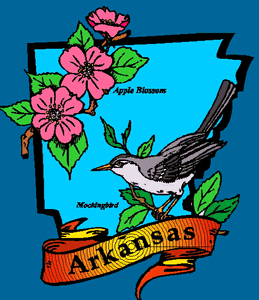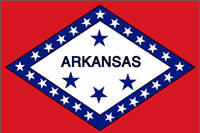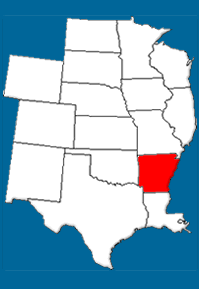


Geography and Landforms:
Arkansas covers 53,182 square miles. The highest point is Magazine Mountain at 2,753 feet above sea level, and the lowest point is the Ouachita River at 55 feet above sea level.
Arkansas can be divided into five main land regions; the Ozark Plateau, the Arkansas Valley, the Ouachita Mountains, the Mississippi Alluvial Plain, and the West Gulf Coastal Plain.
|
 History:
In 1541, the Spanish explorer Hernando De Soto was the first European to set foot in Arkansas, as he led an unsuccessful, yearlong expedition for gold. After this failure, it was 130 years before two Frenchmen, Pere Marquette and Louis Joliet visited Arkansas. In 1682, at the mouth of the Mississippi, Rene-Robert Cavelier, Sieur de La Salle claimed the Mississippi Valley for France, but he was later assassinated by two of his companions. In 1686, Henri De Tonti set out from Fort St. Louis on the Illinois River to meet LaSalle at the mouth of the Mississippi. After he failed to locate LaSalle, De Tonti, the "Father of Arkansas," established the first European settlement in Arkansas, called Arkansas Post, with six residents.
|
 Economy:While it was a major cotton-producing state in the 19th century, Arkansas has since diversified its agricultural production and its economy. The growing use of farm machinery led to the consolidation of many family-run farms into larger farming corporations. Arkansans learned in 1904 that rice could successfully be grown here, and it is now one of its most profitable crops. The livestock and dairy industries have also gained prominence in the last 90 years. Cotton is still an important crop, but now ranks below soybeans and rice. Arkansas is also a leading producer of poultry, turkeys, dairy goods, and catfish. The state's most important mineral products are petroleum, bromine and bromine compounds, and natural gas, and it is the nation's leading bauxite producer. Principal manufactures are food products, chemicals, lumber and paper goods, electrical equipment, furniture, automobile and airplane parts, and machinery. |
 First Inhabitants:
Tens of thousands of people were living in the area now known as Arkansas when the first Europeans arrived in the late sixteenth century. Archaeologists have found evidence that people were living in the area of the Mississippi River as early as 9500 BC, but native populations began to grow between 5000 and 4000 BC.
|
Books Related To ArkansasFire from the Rock - Sharon Draper In Front of God and Everybody - KD McCrite The Legend of Bass Reeves - Gary Paulsen N is for Natural State: An Arkansas Alphabet - Michael Shoulders The Painters of Lexieville - Sharon Darrow Summer of My German Soldier - Bette Greene Where Things Come Back - John Corey Whaley With a Name Like Love - Tess Hilmo |
Famous Citizens:
|
| Capital: | Little Rock |
| Entered Union: | June 15, 1836 |
| Population: | 2,966,369 |
| Area | 53,179 |
| Bird | Mockingbird |
| Flower | Apple Blossom |
| Nickname: | The Natural State |
| Governor | Asa Hutchinson |
Places to Visit in Arkansas: (Click the links to learn more.)
|



